There’s no escaping the buzzword of the moment: AI. How it will affect the additive manufacturing industry is still to be seen. But there is at least one place where it is already in action: generative design software.
Artificial intelligence (AI) and machine learning (ML) have huge potential not only to accelerate and expand the design process but open it up to designers who have less technical expertise. Although some elements of AI are available in design and simulation software products today, it just scratches the surface of what’s possible.
There’s a groundswell of interest in generative design software as these solutions become more powerful, complex, and accessible. They can dramatically accelerate the time to market for parts, products, machines, and even buildings by using AI to automate some of the most laborious parts of designing.
There’s no doubt that computer-aided design (CAD) with AI is a perfect marriage of technologies. But in the rush to the alter, software marketers may have jumped the gun a bit sprinkling the word AI in product descriptions when it’s debatable if is really self-aware AI or just advanced parametric modeling.

Is It Really AI?
Parametric design (generating a design by entering numeric perimeters, i.e. how tall, how long, cost, materials, weight, etc.) and AI are related yet distinct concepts. Parametric design enables designers to create flexible and easily modifiable models that are based on interconnected and variable dimensions and features. On the other hand, AI involves performing design tasks that typically require human intelligence.
Generative design, as a blend of the two approaches, uses computational processes to explore a vast (larger than humans could imagine) design space and generate multiple (even thousands of) design alternatives.
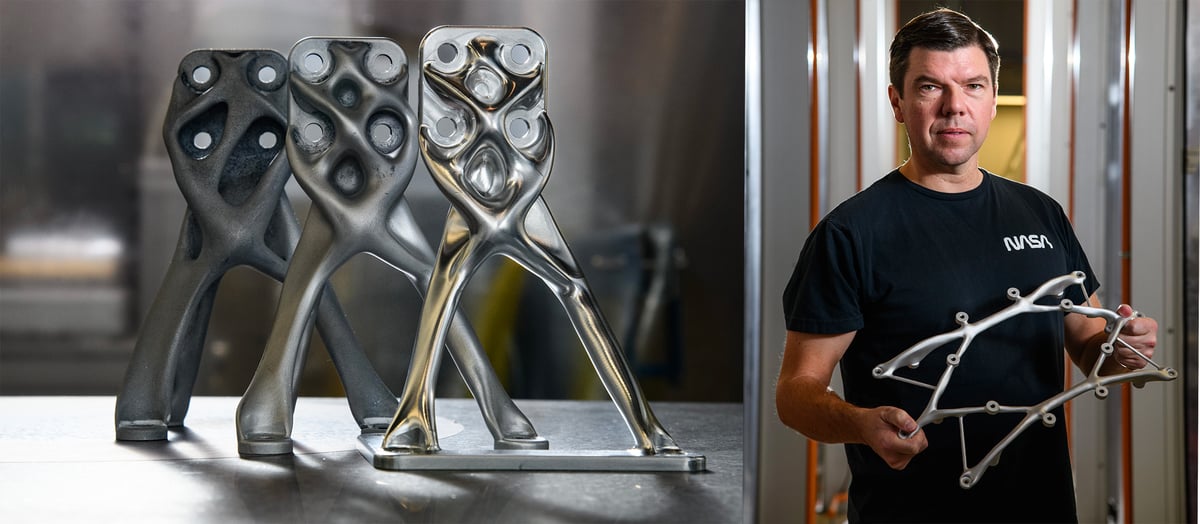
In the context of generative design, an AI-driven algorithm might use machine learning techniques to understand design preferences or learn from historical design data. These algorithms can generate solutions based on generalize knowledge from data, rather than following specific data sets.
AI in generative design doesn’t replace you as an engineer or designer, but it frees you from repetitive tasks and error-prone multiple calculations and resolves conflicting design constraints so you can focus on innovating. This category of software not only saves a tremendous amount of time in the product development lifecycle but delivers more alternatives than human designers have time to create or evaluate manually and, more importantly, concepts you may never have thought possible.
Yet AI must learn to innovate if it is really going to help engineers design, a recent MIT study concluded.
“Deep generative models (DGMs) are very promising, but also inherently flawed,” says study author Lyle Regenwetter, an MIT mechanical engineering graduate student. “The objective of these models is to mimic a dataset. But as engineers and designers, we often don’t want to create a design that’s already out there.”
The study concluded that if mechanical engineers want help from AI to generate novel ideas and designs, they will have to first refocus those models beyond statistical similarity to other priorities, such as performance, design constraints, and novelty.
Today’s computing power and unique designs enabled by additive manufacturing are playing a big part in driving greater use of this type of software. For a deeper dive into what generative design software is or isn’t, skip down to the section: What Does Generative Design Software Really Do? But now, let’s look at your software options.
Pick the Best Software for Your Needs
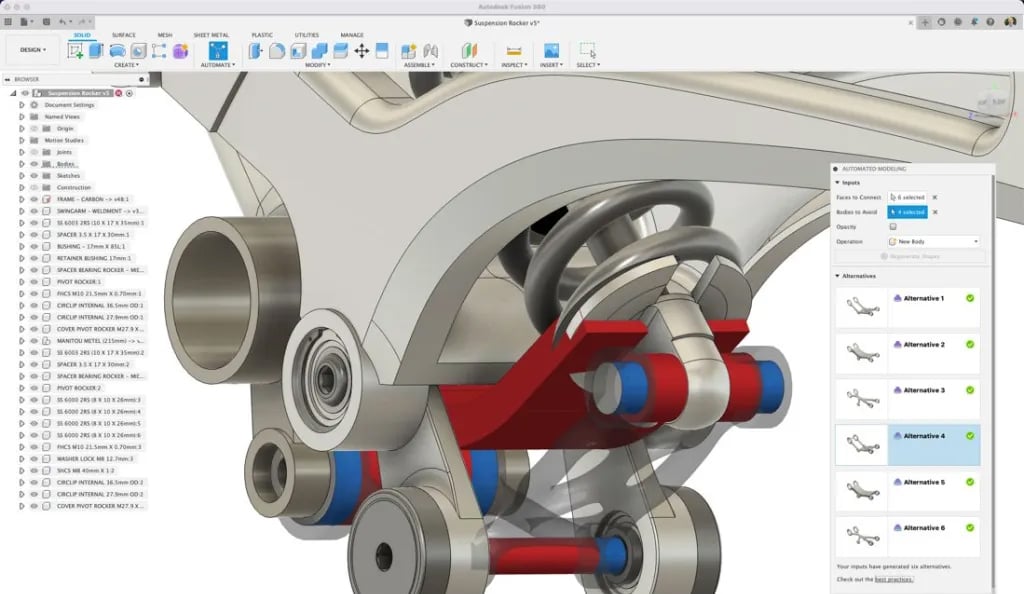
Why do you want generative design software and what processes will you apply it to? These may be the key questions to ask yourself in choosing a generative design software program, but there are others we propose below.
1. Can you create a part in the software or just import your existing design? In other words, how early in the design process can you apply generative design?
2. What perimeters can you define in your software?
- loads
- contacts
- materials
- stress and displacement constraints
- weight
- wall thickness
- manufacturing method
- available design space
- cost
3. Will your part be optimized for just additive manufacturing, or will it consider traditional manufacturing methods and which ones (forging, milling, casting, injection molding, etc.)?
4. Will your generative design solution integrate with your existing CAD or CAE platform?
Fusion 360 Generative Design Extension from Autodesk
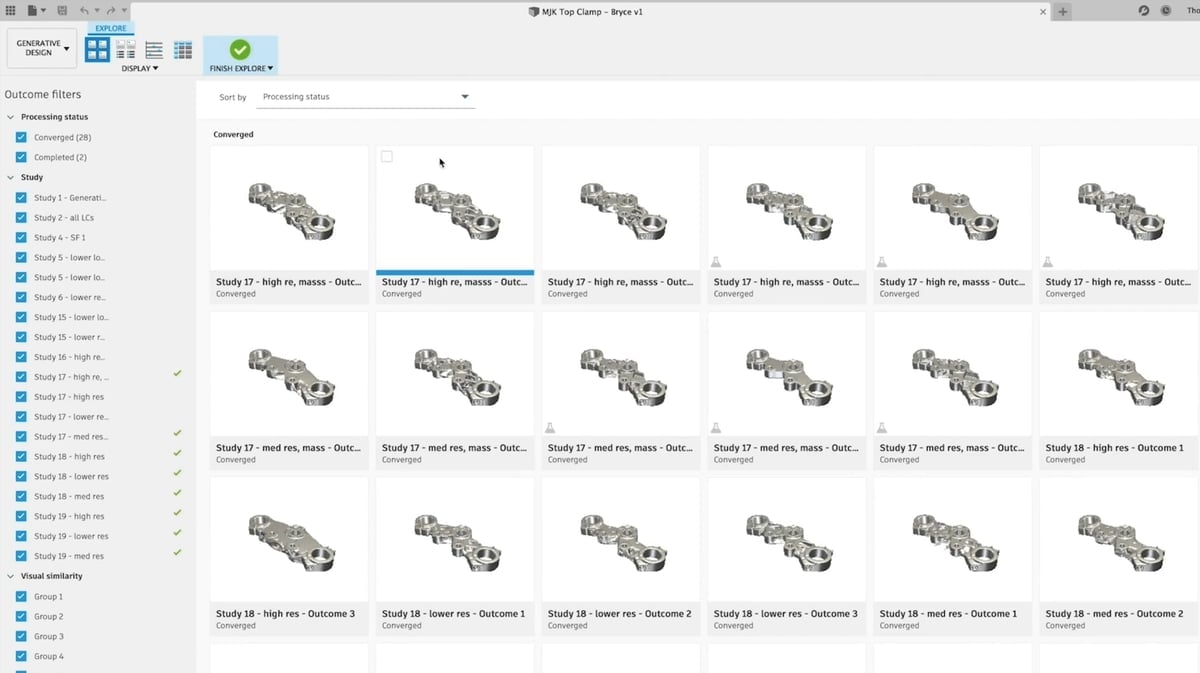
In November 2023, Autodesk, the publisher of several design and manufacturing software platforms, launched “Autodesk AI.” Not a specific product, but rather a focus on AI. Autodesk AI refers to the capabilities already presents in its platforms and a promise that more are on the way. The company’s latest video explainer ends with, “Together we’ll unlock potential that will change everything,” which harkens back to the idea that, for now, AI-design is a bit more potential than it is reality.
On the other hand, the generative design tools inside Autodesk’s Fusion360 CAD program are fast becoming the go-to solution for product designers and engineers. Autodesk’s generative design technology, which used to be an extension for about $1,600, but now it’s a workspace imbedded in the software, enables rapid design exploration by simultaneously generating multiple solutions based on manufacturing constraints, cost, and product performance requirements.
In the latest update to Fusion 360, Autodesk added a new level of robustness to its solver in the Structural Component study to help handle geometry separations. This update keeps the design space connected and allows the solver to iterate further, ultimately giving you a better result. There’s also notable improvement in a design feature called Configurations, which enables you reuse parametric logic to create variations of a design. You might use Configurations to author a family of parts in a product line, define different material and appearance options, create complex variant assemblies, or represent stages in your manufacturing workflow.
Fusion 360 enables you to explore more ideas with one workflow that uses “manufacturing process-aware artificial intelligence” to expand design options well beyond human imagination, Autodesk says, without the need to model and validate each one individually. It will help you uncover options for part consolidation, material reduction, sustainable designs, and manufacturing cost comparisons to weigh commercial production costs against design decisions.
The Automated Modeling tool in Fusion 360 lets you rapidly create and consider multiple design alternatives for connecting two or more faces in your design. The tool is all about increasing your creativity and productivity during the earlier design process.

Case Study
NASA and the European Space Agency (ESA) are planning an ambitious feat with the Mars Sample Return Mission to bring rocks and soil from Mars safely back to Earth for the first time — all with the goal of discovering if life ever existed on the planet. The expected launch of a new NASA Mars lander is 2027 and ab orbiter in 2028. The estimated shipping arrival to answer our life-on-Mars question is 2033. In the meantime, there’s a flurry of new designs and innovations to make the trip to Mars and back happen without a hitch.
Newton Engineering and Product Development is one of the companies helping to develop key parts for the equipment designed to collect samples from Mars. It’s using Fusion 360’s generative design feature to develop lightweight solutions, such as the lid hinge shown above.
“We looked at other tools that do generative design or topology optimization, and no other tools were able to produce ready-to-manufacture parts as easily and as quickly as Fusion 360,” says Alex Miller, lead mechanical engineer at Newton. “Cost is a factor, too. Fusion 360 is a fraction of the cost of other tools.”
Creo Generative Design Extension from PTC
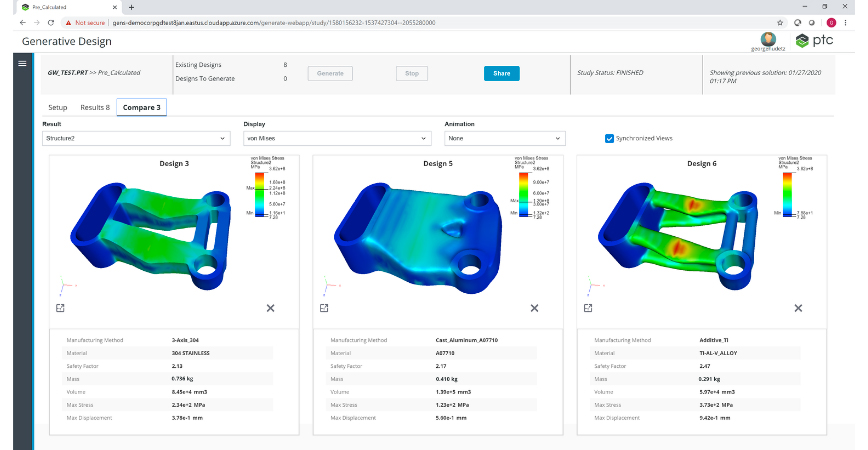
Creo defines generative design as a “3D CAD capability that uses AI to autonomously create optimal designs from a set of system design requirements.”
The company’s Generative Design Extension (GDX) for its popular CAD program, creates optimized product designs to simultaneously explore numerous innovative design options, with top options automatically highlighted. Generative Design automatically delivers high-quality, lower-cost, manufacturable designs, all within the Creo design environment.
Within the Creo design environment, this software promises to generate high-quality, lower-cost, and manufacturable designs, all in less time than leading competitors.
Creo’s generative design extensions are fully integrated into the CAD/PLM/simulation environment. Other software solutions require the importing and exporting of load cases and geometry. PTC’s solution is fully integrated into Creo and is a seamless part of any design workflow, from concept to simulation to production.
The new Generative Topology Optimization extension (GTO) and cloud-based Generative Design Extension help you optimize product designs based on your constraints and requirements – including materials and manufacturing processes. With GTO, you can rapidly explore innovative design options to reduce development time and expense, all within the Creo environment. And cloud-based GDX allows you to simultaneously create multiple designs using different materials and manufacturing scenarios, with top options highlighted for your review. Learn more about how Creo generative design can help you automatically deliver high-quality, lower-cost, manufacturable designs.
Ansys Discovery
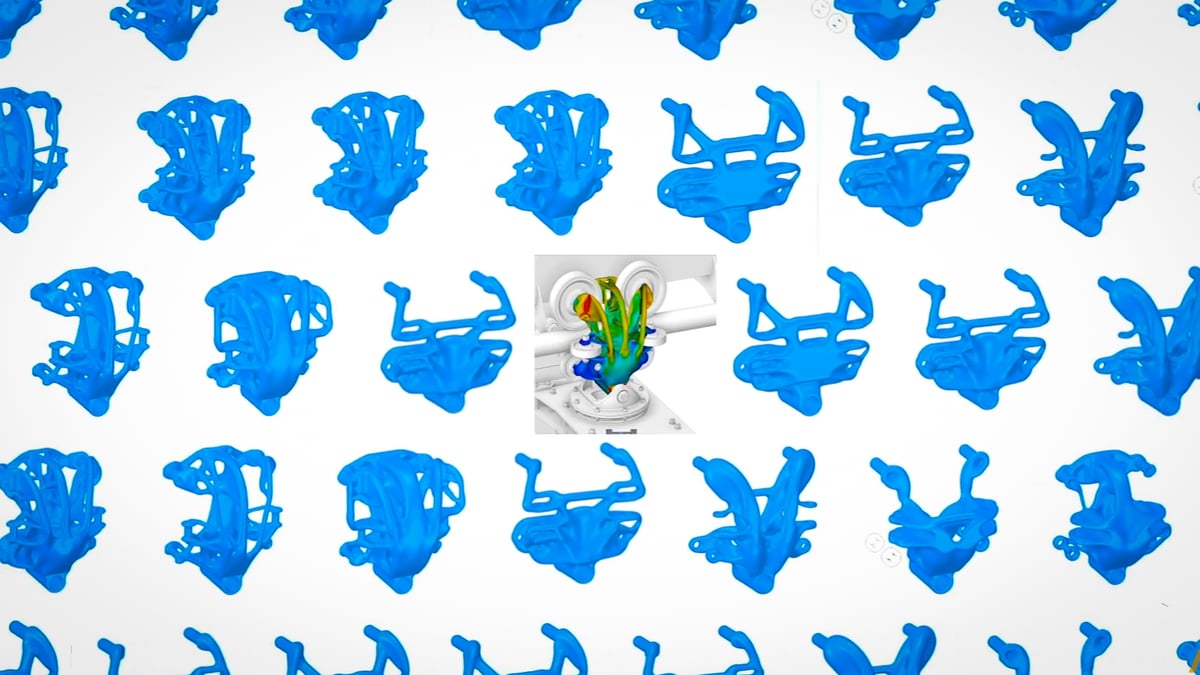
Ansys Discovery enables engineers to rapidly evaluate hundreds of potential shapes for a component through topology optimization and a host of other criteria-based optimization paths. Ansys says Discovery is 3D simulation software with topology optimization, so you won’t see the words “generative design” thrown around, but the end result is the same, the company says.
Ansys Discovery 2023 R2, launched in July 2023, includes new features that help you innovate and explore new product concepts faster and more accurately, the company says. There a new feature to automatically identify common geometry issues that previously derailed the simulation process and group them into easy-to-work-with categories. There’s also a new “repair engine” that automatically corrects issues, resulting in clean, ready-to-simulate geometry the first time.
Ansys says it uses AI and machine learning methods to automatically find simulation parameters to improve speed and accuracy simultaneously and guide early product optimization efforts to help engineers quickly find the best design based on thousands of parameters.
Discovery is a robust piece of software from Ansys that features what the company calls “simulation-driven design.” Ideal for the generative design of parts and products, such as motors, hardware, and mechanical parts that need to have functions, such as air flow, fluid flow, or heat management, in addition to design. Discovery combines instant physics simulation and interactive geometry modeling in a single platform.
By varying design constraints, loading conditions, and allowable regions, Discovery can produce designs that convert to CAD-ready models for additive manufacturing. Engineers can explore various geometries, materials, and physics inputs in record time to arrive at the optimal topology for their product.
Discovery enables you to answer critical design questions earlier in the design process. This upfront approach to simulation saves time and effort on prototyping as you explore multiple design concepts in real-time with no need to wait for simulation results.
In July 2023, Ansys launched Ansys GPT, a virtual assistant trained on natural language processing. Unlike general AI virtual assistants, like ChatGPT, that use unsupported information, AnsysGPT is trained using Ansys data to generate tailored, applicable responses drawn from reliable Ansys resources including, but not limited to, Ansys Innovation Courses, technical documentation, blog articles, and how-to-videos.
Case Study
Techfit Digital Surgery creates implants that support healing bones. Every patient’s needs are unique, whether they’re recovering from cancer or major injuries. The company uses Ansys Discovery to explore different design scenarios. Engineers start with the patient’s unique scan data (CT, MRI) and design supports for it digitally. The software can then validate whether these custom supports are up to the required mechanical standards.
nTop
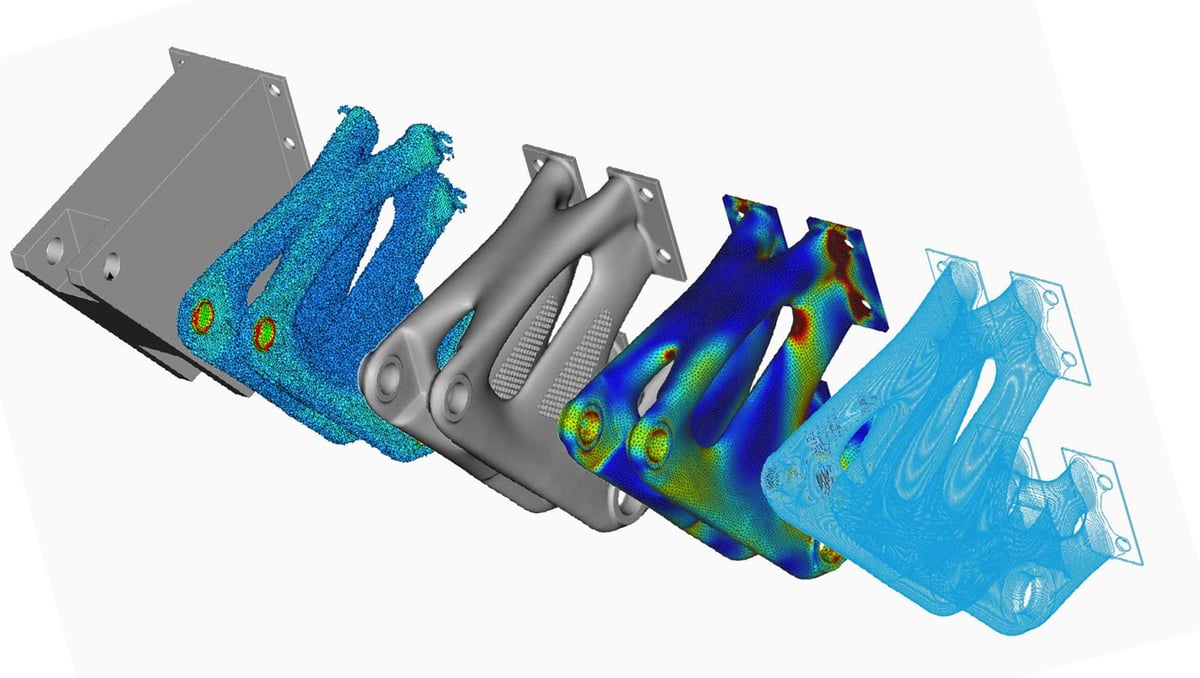
Contrary to its name, nTop (formerly called nTopology) is not just about topology optimization, but the company does define generative design a bit differently than others on this list.
nTop is an optimization platform that enables you to create your own generative algorithms based on your specific requirements. The company aims to give you tools with the necessary level of control so that you can iterate faster and more efficiently, it says. No, it doesn’t spit out dozens of options to choose from, but nTop integrates with scripting tools that do.
According to nTop, there are three core components to generative design: geometry generation, design optimization based on constraints and requirements, and automated design loops.
nTop is built on a unique implicit modeling engine. In implicit modeling, 3D geometry is defined as a mathematical function, not as external surfaces and edges. This feature allows engineers to generate complex structures – like lattices or shells of variable thickness – quickly while providing the reliability needed to feed automated design loops.
nTop (now in version 4) enables engineers to superimpose fields to create optimized structures in a design methodology the company calls Field-Driven Design. For example, simulation results can be used to locally thicken a lattice structure or increase the thickness of shelling operation in areas with higher stresses.
For example, if you want to find the best thickness value so that the part has the minimum possible weight but also a maximum deflection below a certain threshold. In nTop, you can automatically generate design variations with 10 different thicknesses and select the one that is best.
Finally, the software’s design automation capabilities enable engineers to build reusable processes that rerun automatically when the input variables change. This way, you can iterate rapidly and automatically generate multiple design candidates and evaluate them against your engineering requirements.
Although not the standard approach to generative design, nTopology’s software will deliver a part or product optimized to your unique requirements.
Dassault Systèmes CATIA Generative Design Engineering
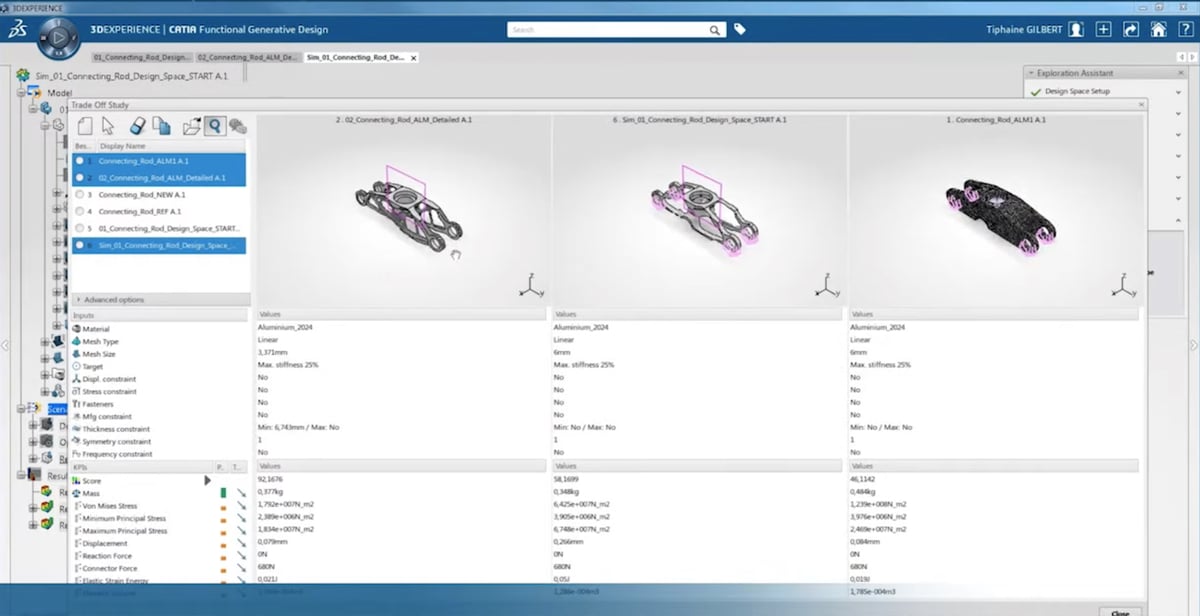
Dassault Systèmes defines generative design as “an iterative engineering process that produces optimized 3D models using AI software and cloud computing.”
CATIA is its multi-platform software suite for computer-aided design, manufacturing, engineering, 3D modeling, and product lifecycle management. Within this robust platform is the Generative Design Engineering (GDE) function.
Unlike the options that automatically generate design alternatives, the GDE offers a multi-step, multi-departmental approach to setting perimeters. It’s targeted at organizations, such as large automakers, where engineering and design is a multi-disciplined process, and designers may not have the expertise in materials or manufacturing methods to optimize a component.
The tool enables non-specialist designers to automatically generate optimized conceptual parts from functional specifications. Start with a basic shape model, validate its general functionality, then provide the functional specifications, such as material, space, load, weight reduction targets, and manufacturing process. GDE generates an optimized part you can then load into the variant manager that has another set of criteria you can apply to generate alternative designs. Compare and assess the best option, then deliver it to engineers using the same CATIA 3Dexperience Platform platform for further enhancement and validation.
The idea here is to enable a collaborative workflow between designers and engineers for conventional or additive manufacturing.
Inspire by Altair
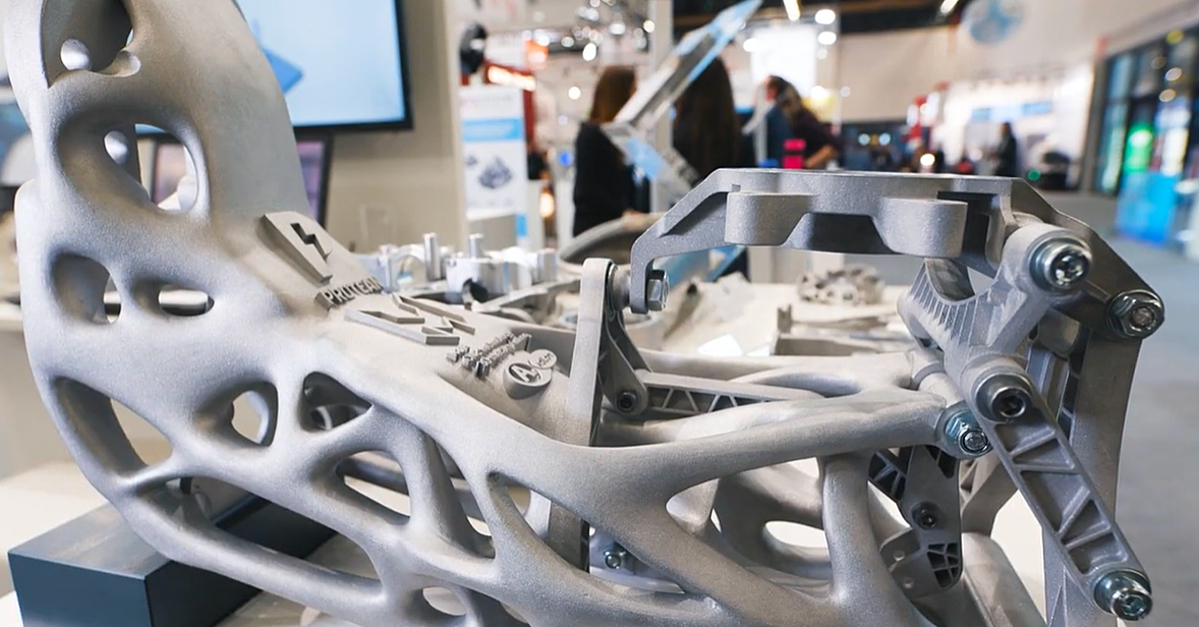
US-based Altair has a long menu of software and cloud solutions for engineering, simulation, and artificial intelligence, among other areas that can be applied to your additive or traditional manufacturing processes, such as forming, casting, extrusion for metals, molding for plastics, and more.
The company’s DesignAI is a cloud-native app that combines “physics-based simulation-driven design and machine learning-based AI-driven design to create high-potential designs earlier in development cycles,” the company says. The idea is to kick-start and augment your product development practices with AI technology to explore a broader population of new product design alternatives. DesignAI can reject low-potential designs earlier in development cycles because it draws from expertise within your organization, drawing on archived simulation and project data. Altair says, “it empowers you to unlock valuable information hidden in existing simulation results .. augment that data with new analysis.”
Altair’s HyperWorks Design Explorer enables teams to “increase collaboration, speed up design convergence, and drive product innovation with AI-powered design tools.” By automating repetitive tasks with machine learning, Design Explorer performs direct modeling for geometry creation and editing, mid-surface extraction, surface and mid-meshing, mesh quality correction, along with assembly management, and process guidance.
Altair offers a suite of solutions for additive manufacturing, including Inspire, OptiStruct, and Studio. Inspire is a family of software products that includes simulation-driven design, generative design, topology optimization, and other features. OptiStruct is more focused on topology optimization to generate an optimal design proposal based on user-defined design space, performance targets, and manufacturing constraints.
Altair’s applications for product manufacturability cover applications tailored to several industries, including automotive, aerospace, electronics, pharmaceutical, and heavy industry. In fact, there are about two dozen simulation programs, including Inspire Print3D, which is specific to creating structurally efficient 3D printed parts using selective laser melting (SLM).
Altair, like some of the other software packages here, is expensive, but they have a special offer for start-ups. The Altair Smart Product Development package is a three-year software plan tailored for startups in product development.
NX & Solid Edge by Siemens
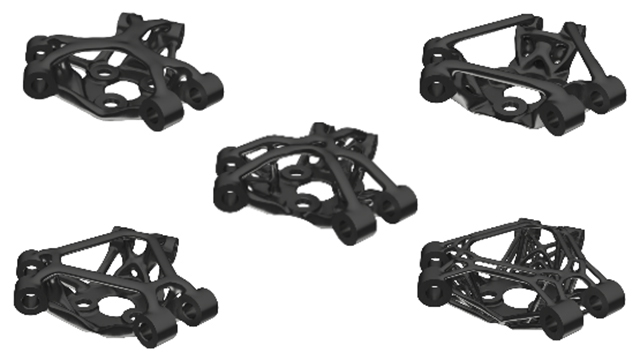
Through its product lifecycle management and simulation businesses, Siemens has long worked with software that eventually became generative design tools. From generative design, Siemens evolved to what it calls generative engineering because it incorporates design, simulation, and manufacturing in a single platform.
The company’s NX platform combines design interoperability, validation, model-based definition, and more to help users move products through research and development faster and at lower costs while improving product quality, the company says. NX design software integrates topology optimization and simulation capabilities in one environment within NX.
Siemens says generative design “is a CAD engineering software function in which a designer collaborates with artificial intelligence algorithms to generate and evaluate hundreds of potential designs for a product idea.”
The Design Space Explorer in NX brings advanced simulation capabilities, commonly done by simulation specialists, right at your fingertips directly in NX, the company says. This feature enables you to define the optimization problem with all parameters, constraints, and objectives in place using Siemens Simcenter HEEDS software.
The platform embeds topology optimization powered by convergent modeling technology with generative design capabilities to essentially present more options to the engineer than were previously possible. In addition to design space exploration, the software enables design iteration based on multiple goals giving users the ability to study the impact of a design change on attributes, such as cost and physical properties.
Given a set of constraints defined by an engineer, this technology autonomously produces a number of alternative designs. With NX, take scanned data or topology optimization results and modify them directly right alongside the traditional CAD model in a single environment. There’s no translation, no moving back and forth between programs.
Siemens NX empowers design engineers by utilizing a set of tools for efficiently employing generative engineering.
There are also generative design capabilities in Siemens’ other CAD product Solid Edge. “Our solution for generative design [in Solid Edge] allows you to replace small assemblies with a single component, reducing manufacturing costs and bill-of-materials complexity. Performing a generative design study can result in interesting new design ideas that can be incorporated into your traditional design process.”
In Solid Edge 2024, Siemens has significantly boosted its AI abilities. Now, the software delivers AI-assisted design in several key enhancements. Now, when replacing parts in an assembly, the new AI assembly relationships capability “intelligently predicts and offers valid alternatives,” the company says. Elsewhere, an AI powered user interface learns use patterns to present relevant commands, in the right context, at the cursor, while a new AI assisted Operation Editing capability in Solid Edge CAM Pro can guide users through the machining operation editing process, offering suggestions based on the machining application and learned part-programming style.
“When used with Solid Edge’s generative design capabilities to automatically design concepts based on defined geometric and functional constraints, they can remove repetitive work from common activities, speed design, and enable designers and engineers to focus on true exploration and innovation,” the company says.
Case Study
When Italian global orthopedics developer LimaCorporate set out to design a 3D printed knee replacement, it needed software that could incorporate its data on the attributes the knee replacement part needed to have. Lima had walking studies that revealed the stresses the part needed to withstand and its ideal placement in the patient. NX automatically computed the optimal lattice volume in the part to guarantee the required strength and stability. Designers no longer needed to struggle with manipulating STL files because they could edit most features of the part with numerical values that are mathematically linked to the geometry.
“In our old process, modifying STL files were disconnected from our workflow so it increased the risk of human error,” says Naeem Hassan, senior additive manufacturing engineer at LimaCorporate. “Now, with everything in a single digital stream and one-click lattice design, our processes are much more efficient.” This increased efficiency is particularly valuable because LimaCorporate isn’t just developing one tibial plate, it’s producing 10 off-the-shelf sizes.
“We’ve reduced AM modeling and job preparation time by 50 percent,” says Riccardo Toninato, additive manufacturing manager at LimaCorporate. “With design optimization, we’re zeroing in on candidate designs with fewer experiments. And having everything in the Siemens software ecosystem has reduced errors and boosted reliability.”
APEX Generative Design
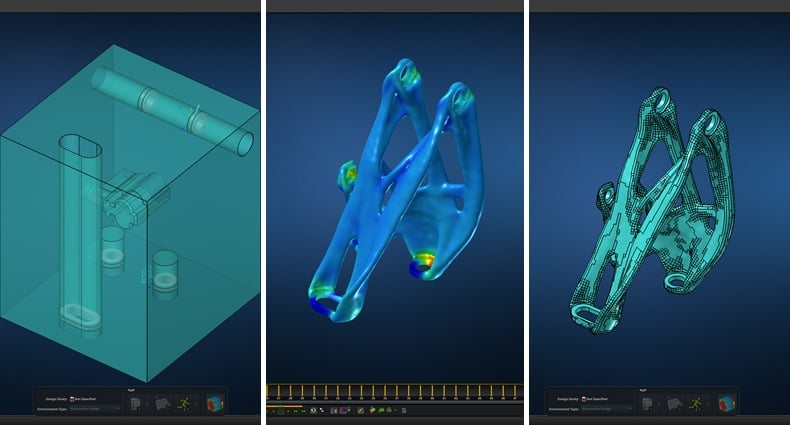
MSC Apex Generative Design from Hexagon is made specifically to generate the detailed and highly complex structures that only additive processes can manufacture, the company says.
In this module that’s part of Hexagon’s Apex software, which is a computer-aided-engineering environment for virtual product development, existing CAD data can be directly imported into MSC Apex Generative Design or created from scratch directly within the software. The software automatically adjusts the rough geometry, refining it until a finer, more detailed structure is achieved.
“By combining multiple steps, users have realized an 80% reduction in design and setup time—from initial geometry to preparation to optimization,” the company says.
Hexagon says no expert knowledge is required for conducting optimizations through a high user-focused software design. The Generative Design almost automatically generates multiple design candidates that all satisfy the design criteria while minimizing the weight.
Designers import existing geometries or mesh, find optimized design candidates, and perform design validation all inside the Apex CAE environment so that the exported geometry can be directly manufactured and used immediately without manual re-work. You can also import the resulting geometries into Simufact Additive or Digimat AM to achieve cost-efficient first-time-right parts, the company says.
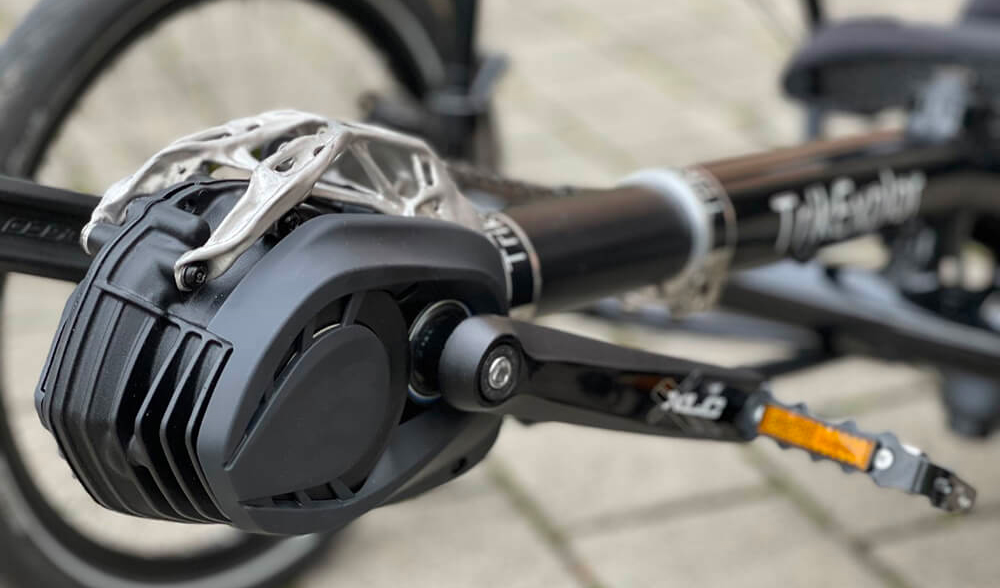
Case Study
E-bike manufacturer Xplorcycles forged the plan to equip the next generation of its bicycles with an electric motor. To connect the 3.2 kg electric motor to the rest of the bike structure, a design existed for manufacturing using conventional manufacturing processes. However, this design was not suitable for small series production and added extra weight. To adjust the part to additive manufacturing, they used Apex Generative Design to generate an AM-ready design that was 55% lighter.
Synera
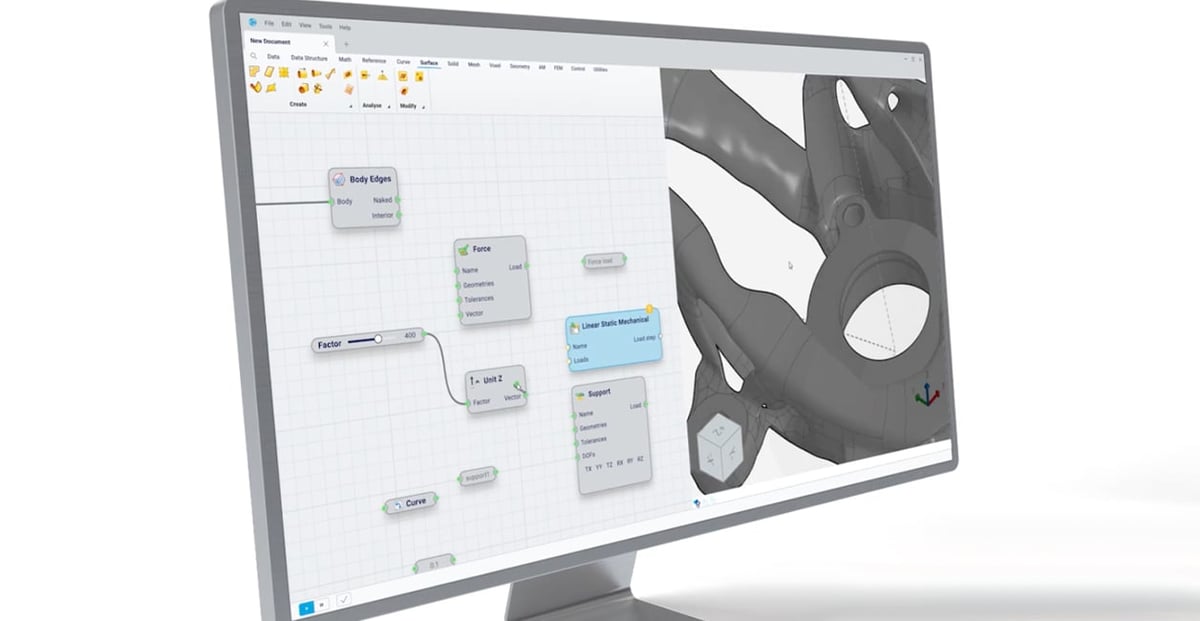
German start-up Synera offers software for “connected engineering” that’s based on algorithms to allow product development steps to be digitally modeled, executed, and systematically reused for new variants or projects in a universal work environment. In other words, it integrats various processes such as requirements, CAD, simulation, optimization, and cost estimation from verious tools, such as Hexagon, Altair, Ansys, and others.
Synera calls its solution generative engineering because it’s not just about design. Where some generative design programs stop at offering a selection of optimal designs. Of those, the top candidates often need to actually be developed by engineers, put through simulations, then prepped for manufacturing. The Synera platform doesn’t start with a base model part, but instead a set of technical conditions, such as design constraints, material costs, production requirements and performance in the real world. Then it defines all possible product variations that would satisfy those conditions.
With Synera, the designer does the work of describing the design task, then the computer takes over. The open software platform enables faster development of more innovative products, the company says.
Case Study
A van powertrain manufactured by the IFA Group features a center bearing for the drive shaft that was developed with Synera software. It weighs 18 percent less than its predecessor. And although the new part was developed in 80% less time, it is stiffer and therefore better than the part used before.
The bearing is made by Henniges Automotive, which used Synera in the development of the aluminum die-cast part instead of the usual design process in the automotive industry: design changes are calculated, checked, and validated in different departments of the company then the results go back to the developer and the loop starts all over again. “In our specific case, we skipped at least 30 such iteration loops,” says project engineer Seipel, which saved Henniges several weeks of development time.
Carbon CogniCAD 5.0
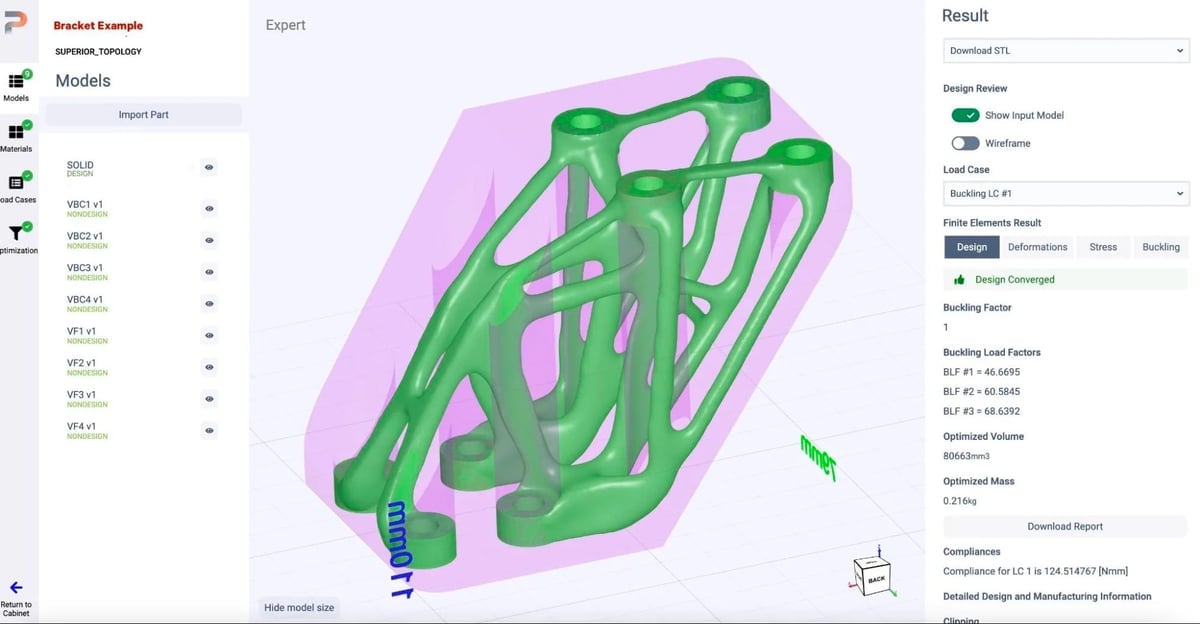
CogniCAD is an autonomous generative design, topology optimization, parts consolidation, and lightweighting software solutions to assist users in automatically generating ready-to-3D print, lightweight structures for aerospace, automotive, and other applications.
Unlike nTop or CATIA Generative Design Engineering, CogniCAD is a fully automated workflow based on proprietary topology optimization, high-resolution finite element analysis, and computational geometry that requires no manual adjustment or reconstruction. If your part is highly unique with a set of custom perimeters, this may not be the best solution, but if you’re looking to optimize a common part, such as a bracket, the pre-set tools may be just the thing.
CogniCAD has features that enable the design of passive cooling devices and heat sinks by setting perimeters for thermal loads and thermal compliance. It can also generate designs that use multiple materials to reduce the weight and manufacturing costs of a wide range of part geometries.
Designs generated by CogniCAD are ready for manufacturing (as STL or STEP files) within tens of minutes up to a few hours, the company says. In July 2023, CogniCAD added buckling as a constraint in its generative design, but there hasn’t been many developments in the program since 3D printer maker Carbon bought its maker ParaMatters in mid 2022.
Generative Design for Architecture
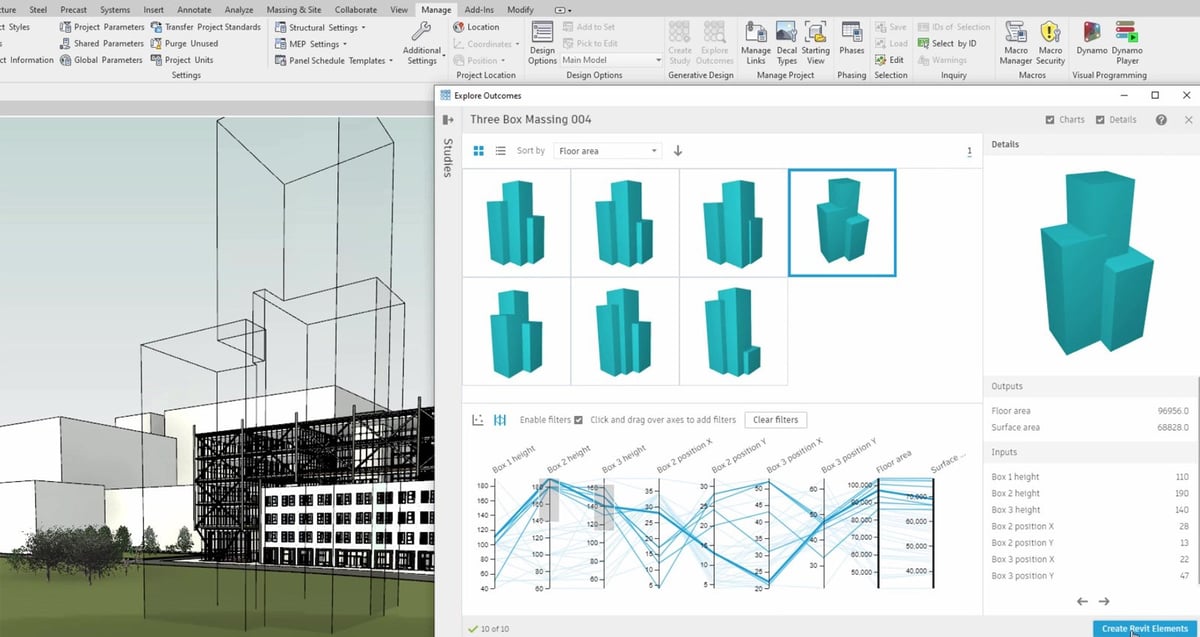
Autodesk Forma
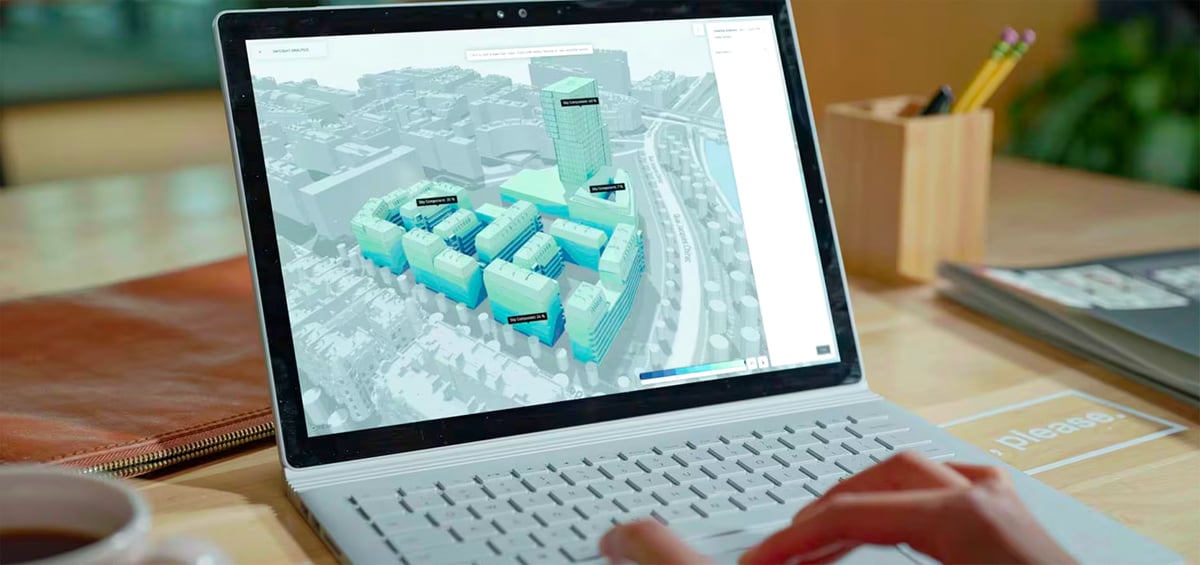
Autodesk Forma (formerly Spacemaker) helps planning and design teams deliver projects digitally from day one. Use conceptual design capabilities, predictive analytics, and automation to make solid foundations for your projects. This cloud-based AI software from Autodesk empowers teams to collaborate, analyze and design real estate sites faster by starting with a set of perimeters that lets the software optimally configure. With Forma, you can improve your site proposal at any time and instantly understand the impact of the changes made.
Using Forma to test design ideas and prove their qualities in the early phase helps teams work more effectively to avoid redoing designs later in the process and create better projects as a whole, the company says.
Forma’s machine learning performs real-time analyses across key density and environmental qualities such as sunlight, daylight, wind, and microclimate, without users requiring deep technical expertise. Now, environmental analyses can be completed from day one of the design process to meet sustainability requirements and targets.
Autodesk uses the AI it has developed for design, manufacturing, and architecture for a new application showing how it could be applied to nearly any creative process that has definable constraints and variables.
Autodesk Revit
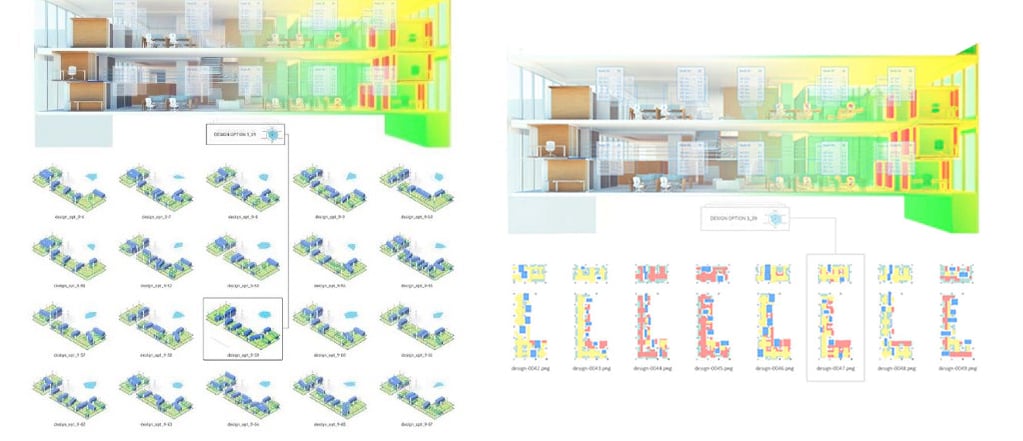
Generative Design in Autodesk’s popular building information management software Revit debuted with Revit 2021. It quickly generates design alternatives based on your goals, constraints, and inputs (such as space, cost, and configuration) to give you higher-performing options for data-driven decision-making.
Autodesk’s Generative Design also includes ready-made studies that you can customize for your specific challenges and standards. For example, you can run a study to optimize rentable space within a building and then take your selected design back into Revit. Say you were looking for the optimal desk configuration in an office that enables the most workspaces but minimizes the distance to exits. These are perimeters you can set to generate a range of possible options.
In 2023, Autodesk launched a stand-along generative design tool called Forma that offers a Revit add-in that provides a file-less sync between Forma and Revit, allowing users to detail their Forma data in Revit and bring it back to Forma for analysis.
Bentley Systems’ GenerativeComponents

Quickly explore a broad range of “what-if” alternatives for even the most complex buildings with GenerativeComponents computational design software. Bentley Systems’ GenerativeComponents is an associative and parametric modeling system used by architects and engineers to automate design processes and accelerate design iterations. It integrates with the company’s popular MicroStation and AECOsim Building Designer software and gives designers and engineers new ways to efficiently explore alternative building forms without manually building the detailed design model for each scenario. It also increases their efficiency in managing conventional design and documentation.
GenerativeComponents captures and graphically presents both design components and abstract relationships between them. This capability lets GenerativeComponents go beyond making geometry explicit; it makes design intent explicit as well. Although designers are working graphically, based on intuition and experience in architectural design, their work is captured in logical form.
Case Study
The Greenland Center in China is a 306,000-square-meter mixed-use complex featuring two 301-meter-tall towers linked by a sinuous podium building. The design integrates a practical layout within the urban space, while the parallelogram plan geometry with rounded corners distinguishes the complex from adjacent rectilinear towers. John Portman & Associates brought the project team together early in the design process to coordinate strategies for efficient construction, materials, water, energy, daylight, and site usage. The integrated BIM model provided a valuable collaboration platform. The architects used a working model with GenerativeComponents to optimize the design of the enclosure and structural system, and then easily integrated the complex geometry with AECOsim Building Designer. This integrated model was used to prepare architectural plans, elevations, sections, details, and schedules. Because sections could be cut early in the design process, problems with clearances and interferences between architecture and structure were detected early, allowing the design to be refined at an early stage.
Sidewalk Labs Delve
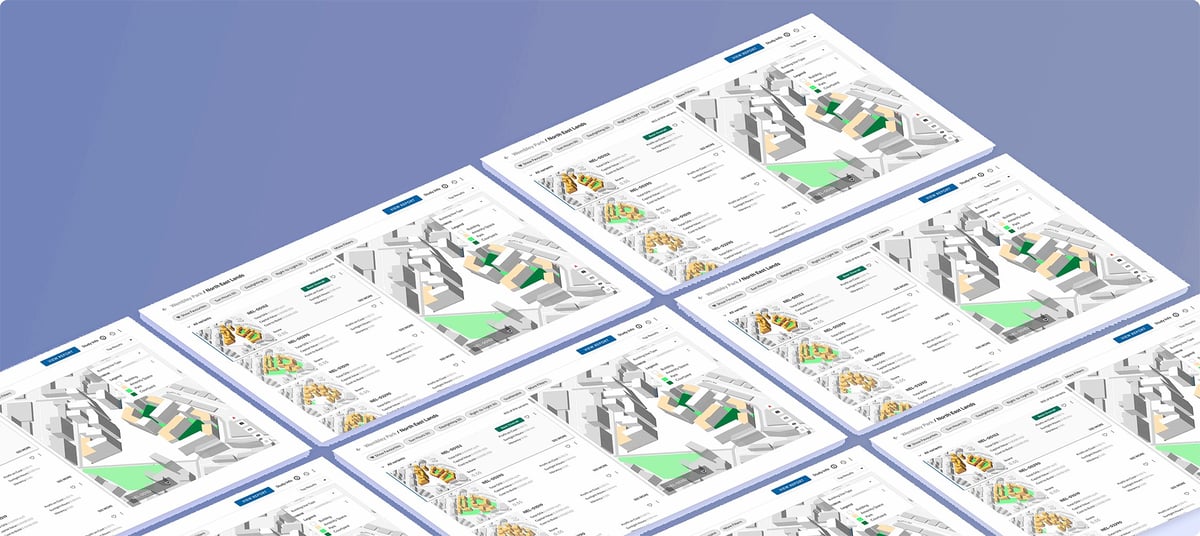
Sidewalk Labs, a Google company, unveiled Delve, a generative design urban planning tool that aims to help developers, architects, and designers identify better neighborhood design options. It uses machine learning to reveal optimal design options from core components, including buildings, open spaces, amenities, streets, and energy infrastructure. By applying machine learning, it explores millions of design possibilities for a given project while measuring the impact of design choices.
Delve is a cloud-based tool that “empowers real estate teams to design better, faster, with less risk,” the company says. Delve integrates your financials, energy models, and site constraints so everyone is on the same page.
Case Study
Quintain Ltd. engaged Delve to raise project density while minimizing daylighting and cost impacts, solving for complex project requirements in a 12-acre mixed-use development on the North East Lands site in Wembley Park, London.
Using Delve, Quintain generated, evaluated, and optimized 40,000 variants that increased the number of housing units (i.e. “unit yield”) while preserving the quality of the environment over an existing benchmark design. By the end of the 8-week engagement, Delve produced 24 high-performing variants that exceeded all goals across unit yield, usable built area, daylight access, sun hours on the ground, and daylight impacts on neighbors.
What Does Generative Design Software Really Do?
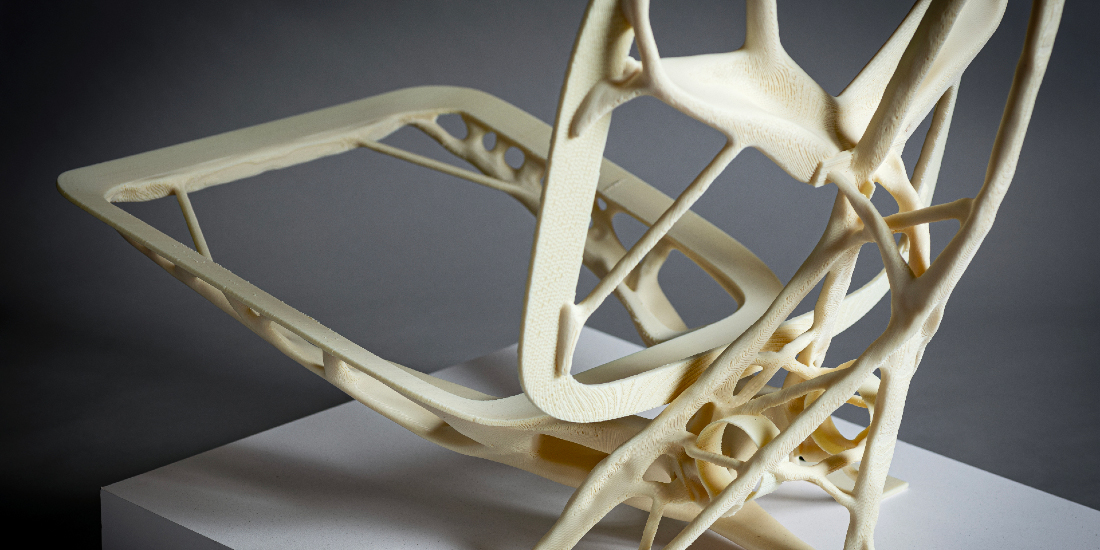
You don’t need to create a design first, then test and validate it. You can input what the part needs to do, the space it needs to fit into, how it needs to function, what stresses it needs to withstand (and more), and the software will generate part design options, recommend how it could be manufactured, and break down costs. It’s a new way of thinking about design.

Despite this, there’s no single definition of generative design software. Vendors in this space use the term liberally as they add and refine the features in their software platforms.
Generative Design Software, a Mixed Bag
Your generative design software may include built-in testing and simulation. It may deliver opportunities for part consolidation and lightweighting. Some products feature several of these attributes but don’t use the label generative design, which makes comparing software in this rapidly evolving category a bit of a challenge. You’ll also hear the term generative engineering in this space, which has yet to have a clear definition but generally refers to an AI-generated design that also meets performance criteria and is manufacturing-ready.
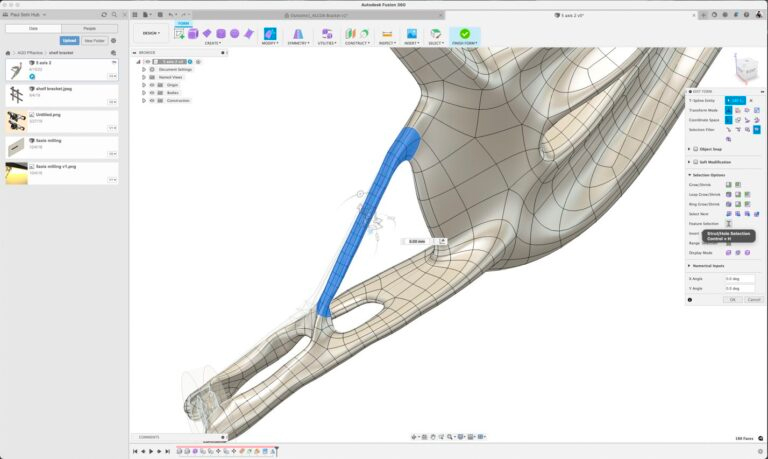
At its core, we’ll venture to say, generative design is a design process using AI and computations to generate results so numerous and varied that they would be difficult, if not impossible, for a human designer. However, many software products we feature below reflect the belief that generative design is simply using algorithmic methods to transform requirements into product geometry and design. They don’t generate dozens of options, rather they refine a single part (which sounds a lot like parametric design).
Some generative design software offerings are stand-alone products and some are extensions within larger engineering platforms. Either way, they both provide a path to a larger exploration of potential design solutions; they don’t necessarily spit out the solution, at least not yet. In some instances, the generated part is directly manufacturable in both additive and subtractive ways, but more often, depending on the robustness of the software, you’ll get very inspiring design alternatives that you can then develop in your CAD/CAE software. You may also get solid engineering data that you can use to alter and optimize your base design without having to export it to another piece of software.
Experts agree that – although it may get there in the future – generative design software is not AI-automated design, it’s a tool to help designers and engineers save time and expand possibilities.

Let’s look at one example. MAN, the German maker of buses and trucks, launched a project last year called “Disruptive Bus Concepts,” in which it sought to rethink the design of bus parts, including the rear axle. For a design study of the rear axle, MAN engineer Amélie Jacquemart-Purson used generative design software from start-up company Elise. The goal was to optimize the existing design of the rear axle in terms of performance, lightweight design requirements, and production.
By importing a set of technical parameters for the axle containing design and manufacturing constraints, Elise generated a rear axle 36% lighter than the current design, together with improved mechanical performance. The result was so convincing that MAN decided to explore this path. They said that the automatic generation of different concepts, as well as a more precise estimation of the variants with regard to durability and weight, reduced the development time drastically. “In the future, we expect to reduce the development time of the finished component with this software by up to 50%,” says Michel Troitzsch, concept engineer in the Disruptive Bus Concepts project at MAN pre-development.
If you’d like to know more about generative design in general, check out our primer: “What Is Generative Design? – Simply Explained.” If you’re ready to get started, below we detail the best software for generative design, covering the top features and ease of use for both engineers and architects.
Lead image source: Generative Design software by Ansys.
License: The text of "The Best Generative Design Software in 2024" by All3DP Pro is licensed under a Creative Commons Attribution 4.0 International License.

